2019 Dodge Charger R/T Scat Pack vs. 2019 Kia Stinger GT: Which Sports Sedan Packs a Bigger Punch?
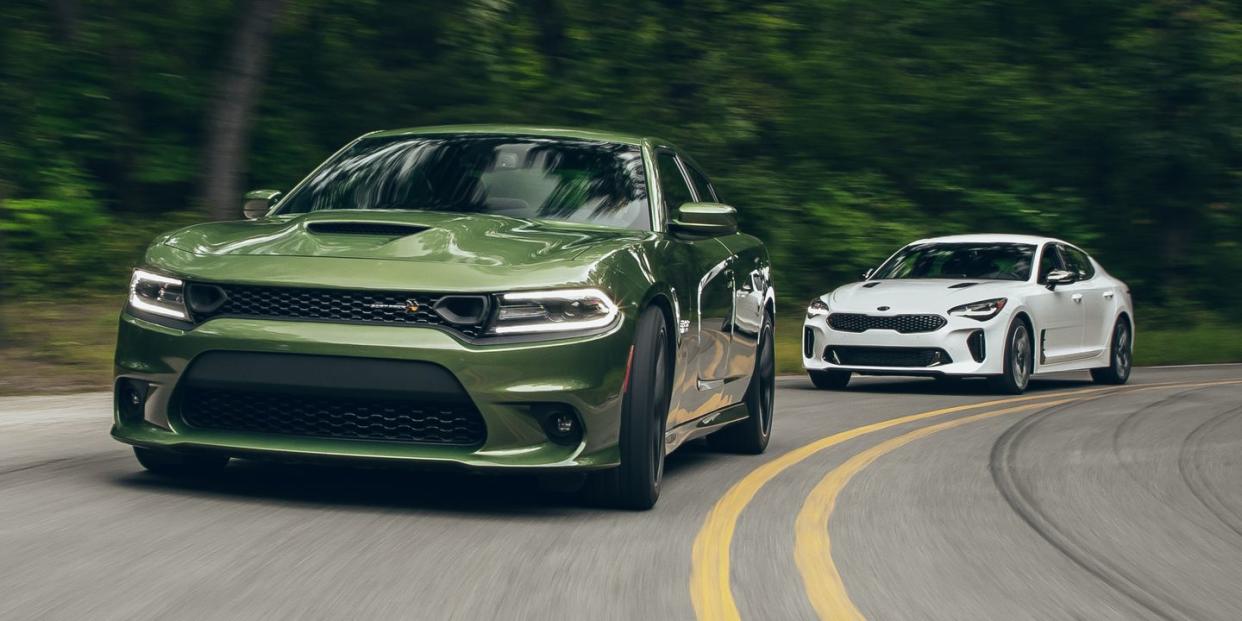

The Dodge Charger R/T Scat Pack and Kia Stinger GT exist for entirely different reasons and cater to entirely different audiences. Yet, they both have rear-wheel drive, powerful engines, starting prices around $40,000, four doors, and reasonably roomy rear seats. Sounds to us like the makings of a natural comparison test.
While Kia has pitched the Stinger as a direct shot at the BMW 3-series, it doesn't fit so neatly into the compact luxury-sport sedan segment. It's larger than many of the four-doors in that class, and its character is somewhat less than luxurious. If the Stinger were an athlete, it would play rugby rather than golf. While it can't quite be considered a muscle car—not least of all because it doesn't offer a V-8—we think it serves as an interesting foil for America's leading (and only) muscle sedan, the Charger.

The Matchup
We might miss a V-8 more if the Stinger GT's twin-turbocharged 3.3-liter V-6 weren't so strong. It makes 365 horsepower and 376 lb-ft of torque, and in our experience, it feels even more powerful than those numbers suggest. The base $40,915 GT model we tested doesn't bother with extraneous features available on the GT1 and GT2 trims, focusing instead on the standard performance bits such as a limited-slip differential and Brembo brakes. Without the optional all-wheel drive, this lightly optioned Stinger is somewhat of a featherweight, weighing 3921 pounds, or 236 pounds less than a fully loaded Stinger GT2 AWD we previously tested.
The Charger R/T Scat Pack sounds rowdy based on its name alone, and that rings true—even if it isn't the full-bore, supercharged SRT Hellcat model. With a massive naturally aspirated 6.4-liter V-8 underhood, the Dodge has the Kia beat on power, making 485 horses and 475 lb-ft of torque. This $45,930 example also came equipped with performance upgrades such as adaptive dampers, more aggressive 20-inch wheels and tires, and Brembo brakes. Like the Kia, it's also rear-wheel drive (all the better for smoky burnouts) and routes power through an eight-speed automatic transmission. Its big muscle advantage is offset somewhat by its mass, as it weighs in at a whopping 473 pounds heavier than the Kia.
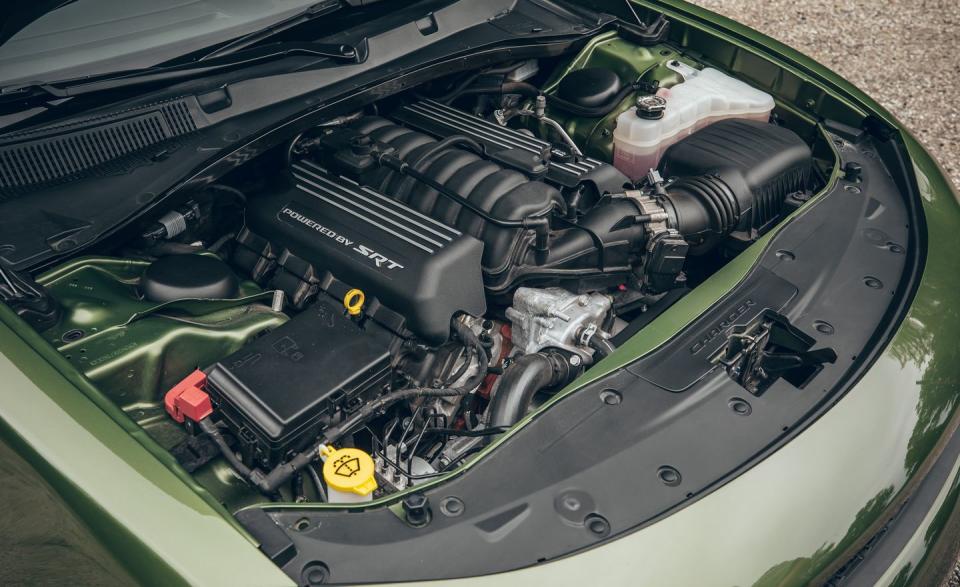
On the Road
The difference in size between these two cars is the single biggest factor in how they drive. Where the Charger is big and brutish, the Stinger is agile and nimble. The Dodge feels twice as wide on narrow twisty roads, even though it's only 1.4 inches wider in actuality. This makes it somewhat less eager to change direction than the Stinger, which exhibits sharp turn-in responses and a nice sense of balance. But that's not to say the Charger doesn't know how to dance. It's fun to drive in its own special way, with satisfyingly heavy steering and a high grip threshold. The Dodge's extra weight also makes it feel more planted and buttoned-down than the Kia, which lacks a measure of wheel control on bumpier roads that sometimes can make it feel skittish.
At the test track, the burly Dodge surprised us by beating the Stinger in both lateral grip (0.95 g to the Kia's 0.92 g) and in 70-to-zero-mph braking; the Dodge came to a halt in a short 150 feet, or nine feet longer than the Stinger could manage. Tires are certainly a factor here. Both cars were fitted with summer tires, with the Charger shod with aggressive 275-width Pirelli P Zero rubber all around, and the Stinger sporting a staggered Michelin Pilot Sport 4 setup with 225-width tires in the front and 255s in the rear.
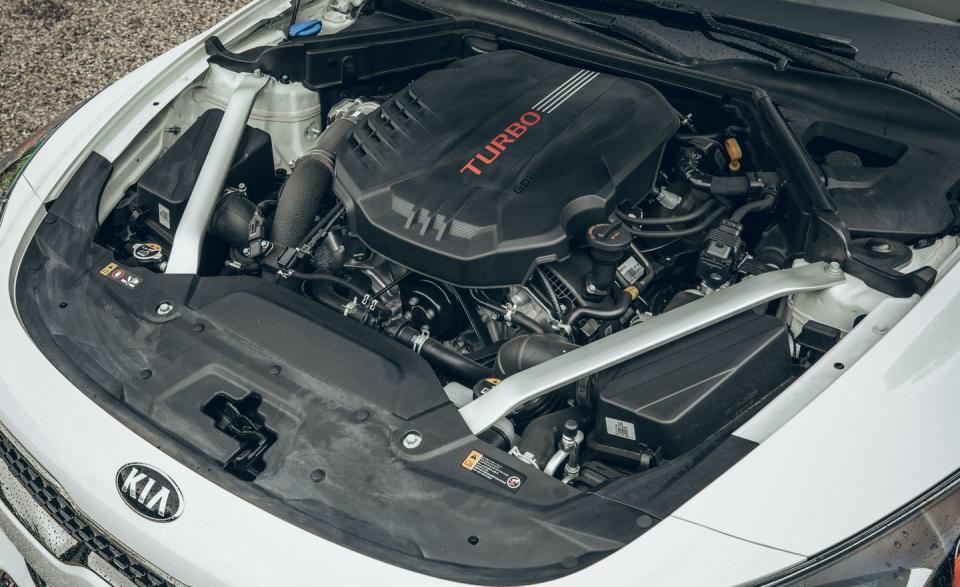
Subtlety is not the Charger's strong suit. The Hemi V-8 makes a stir everywhere it goes, with a distinctive roar that turns heads and a loud exhaust that has a way of disturbing the peace. It's not all for show, either, as the Charger bolted from zero to 60 mph in an impressive 3.9 seconds, outmuscling the Kia's still quick 4.4-second run by a half second. The margin is similar through the quarter mile, where the Dodge runs 12.3 seconds at 115 mph versus the Stinger's 12.9-second pass at 110 mph.
When you're not at the drag strip, though, the Dodge struggles to puts its power down smoothly. Its throttle feels like an on-off switch, making it hard to roll into the V-8's generous torque without overdoing it. The Kia's considerably quieter V-6 may not have the presence or charisma of a V-8, but it responds to throttle inputs more naturally, giving it a lively feel without being jumpy. The twin turbochargers spool up quickly, and its eight-speed transmission kicks down effortlessly, meaning the Stinger gains speed with more poise and precision than the Dodge's brute-force approach. Plus, to no one's surprise, the Stinger dominated the Charger in fuel economy. The V-6–powered Kia sipped fuel at a rate of 23 miles per gallon compared to the V-8 Dodge's 17 mpg.
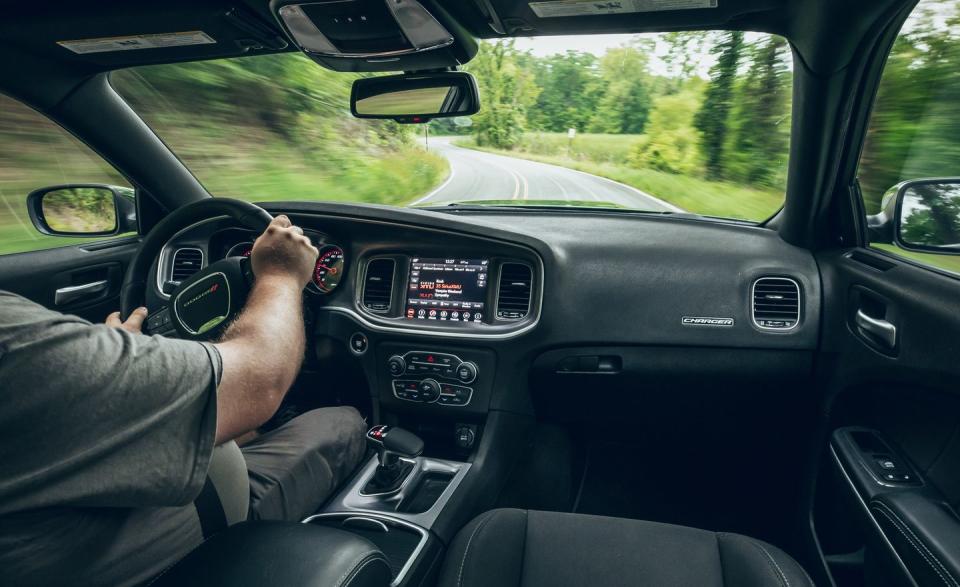
The Inside View
As ostentatious and attention-grabbing as it is on the outside, especially in our test car's attractive F8 Green paint, the Charger's interior is decidedly dour and unimpressive. Our test car was equipped with ordinary-looking cloth upholstery with a houndstooth pattern, and the dashboard materials fall closer to the rental-car end of the spectrum than you'd think given its $40K-plus pricing. The Stinger is luxurious in contrast and comes closer to living up to its pricing with a far more modern-looking dashboard design and eye-catching red leather upholstery.
The Dodge's cabin feels claustrophobic, although the rear seats are comfortable thanks to thickly padded cushions. The Stinger's rear quarters feel airier and more spacious, although the seat's bottom cushion is too low to be truly comfortable for adults, and there's not much foot room under the front seats. The Charger has a big trunk for a sedan, at 17 cubic feet, but the Stinger's capacious 23-cubic-foot hatchback beats it soundly.
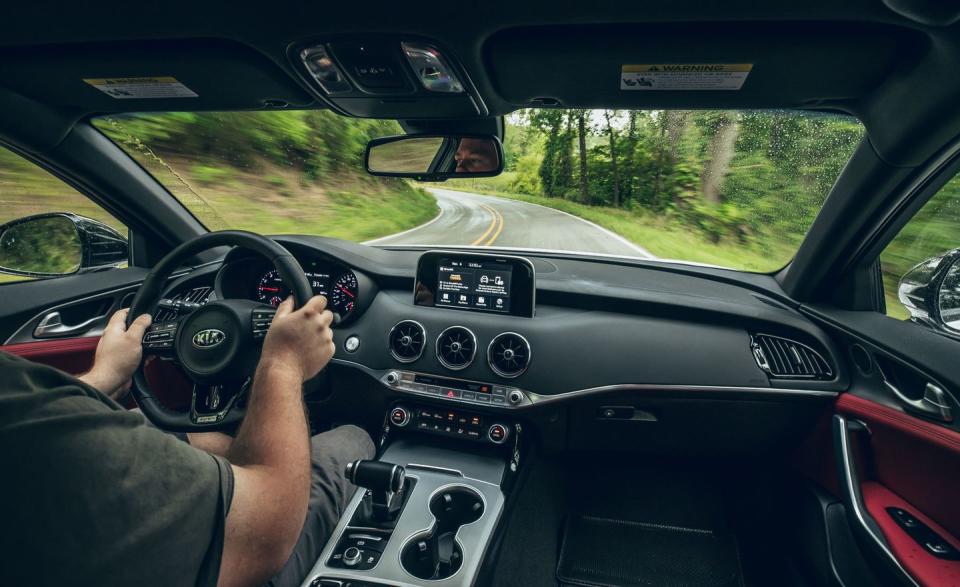
Both cars feature easy-to-use infotainment systems. The Dodge's 8.4-inch touchscreen uses Fiat Chrysler's logically laid-out Uconnect software and responds quickly to prods from your fingers. The Stinger's smaller 7.0-inch touchscreen is not as visually impressive, but it, too, has a menu structure that's simple to navigate. Higher Stinger trim levels come with a larger touchscreen and a digital instrument cluster, but we didn't miss those extras much given how well everything works inside the Kia.
The Bottom Line
How you feel about the difference in price between the $45,930 Dodge and the $40,915 Kia will depend on what you're willing to pay for. The Charger has the clear edge in terms of outright performance, and it's exactly as loud, mean, and brash as a V-8–powered American sedan should be—even more so if you opt for the Scat Pack's new-for-2020 widebody package that adds fender flares and even fatter tires. If a true muscle car is what you're after, it's the only choice here.
But for several thousand dollars less, the Kia strikes us as the better-rounded choice of the two, with performance numbers only slightly behind the Dodge's and a more premium demeanor and distinctive appearance that make it feel like a considerably more special vehicle overall. Although we appreciate the Dodge's in-your-face attitude, it's the Stinger's more nuanced approach to sports-sedan excellence that sways us.

You Might Also Like

